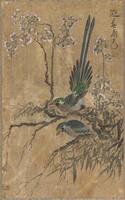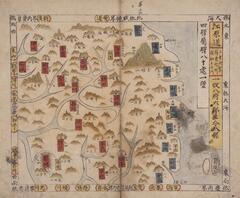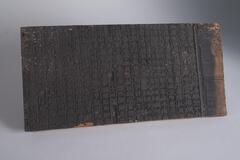12 UMMA Objects
12 UMMA Objects

Korean (Korean (culture or style))
Birds and Flowers
19th century
Gift and partial purchase from Bruce and Inta Hasenkamp, purchase with funds from Elder and Mrs Sang-Yong Nam
2021/1.165
![A square porcelain water dropper. The porcelain is white and there is an image of a lizard or dragon on the top. Clouds are depicted on the sides with the image of a flying crane on the front of the square. The white glaze has chipped of or is thin in places, revealing the copper underglaze.<br />
<br />
This is a cubic water dropper featuring an openwork design of a crane with wings spread on the upper face. The spout is in the shape of a newt; it is designed in the way that water drops from the mouth of the newt. The side walls feature cloud designs in copper red which were blackened during firing. The entire foot was glazed, but the glaze was wiped away from the foot, on which were placed fine sand support during firing.<br />
[Korean Collection, University of Michigan Museum of Art (2014) p.182] A square porcelain water dropper. The porcelain is white and there is an image of a lizard or dragon on the top. Clouds are depicted on the sides with the image of a flying crane on the front of the square. The white glaze has chipped of or is thin in places, revealing the copper underglaze.<br />
<br />
This is a cubic water dropper featuring an openwork design of a crane with wings spread on the upper face. The spout is in the shape of a newt; it is designed in the way that water drops from the mouth of the newt. The side walls feature cloud designs in copper red which were blackened during firing. The entire foot was glazed, but the glaze was wiped away from the foot, on which were placed fine sand support during firing.<br />
[Korean Collection, University of Michigan Museum of Art (2014) p.182]](/media/W1siZiIsIjIwMjIvMDkvMjQvMzUzdHd1ZXN1a19kZWZhdWx0LmpwZyJdLFsicCIsInRodW1iIiwiMjQweDIwMCJdXQ?sha=316cc0fb017387a9)
Korean (Korean (culture or style))
White Porcelain Square Water Dropper with Openwork Cloud and Crane Design
1867 – 1899
Gift of Bruce and Inta Hasenkamp and Museum purchase made possible by Elder and Mrs. Sang-Yong Nam
2004/1.279
![Inlaying silver into ironware was a popular method of decorating metalwork that required high levels of skill. Numerous items were produced with inlay decorations. The entire lid and body of this hexagonal case are decorated with inlaid silver. The lid features a hexagonal design in its center surrounded by a continuous four-leaf flower design. The six sides of the body are decorated by three pairs of turtle designs, crane designs and deer designs, arranged alternately. The lid and body are bordered with a fret-patterned band. This case with a flat base is excellently preserved. This type of iron-lidded case with inlaid silver design was produced in large quantities from the nineteenth century to the early twentieth century, continuing through the Japanese annexation of the Korean Peninsula. Such cases are mostly octagonal; this is a rare hexagonal example.
<p>[Korean Collection, University of Michigan Museum of Art (2017), 244]</p>
Inlaying silver into ironware was a popular method of decorating metalwork that required high levels of skill. Numerous items were produced with inlay decorations. The entire lid and body of this hexagonal case are decorated with inlaid silver. The lid features a hexagonal design in its center surrounded by a continuous four-leaf flower design. The six sides of the body are decorated by three pairs of turtle designs, crane designs and deer designs, arranged alternately. The lid and body are bordered with a fret-patterned band. This case with a flat base is excellently preserved. This type of iron-lidded case with inlaid silver design was produced in large quantities from the nineteenth century to the early twentieth century, continuing through the Japanese annexation of the Korean Peninsula. Such cases are mostly octagonal; this is a rare hexagonal example.
<p>[Korean Collection, University of Michigan Museum of Art (2017), 244]</p>](/media/W1siZiIsIjIwMjIvMDkvMjQvOThqa2s3NjF5M19kZWZhdWx0LmpwZyJdLFsicCIsInRodW1iIiwiMjQweDIwMCJdXQ?sha=8a82c3ce8eccee83)
Korean (Korean (culture or style))
Hexagonal Tobacco Box with Lid
1850 – 1950
Gift of Bruce and Inta Hasenkamp and Museum purchase made possible by Elder and Mrs. Sang-Yong Nam
2004/1.280A&B
![It has a long, thin neck and flat oval body. The wide foot is rather shallow but deeply recessed on the underside. The entire of surface is decorated with peony blossom design printed in cobalt blue sigment.<br />
<br />
This is a long-necked white porcelain bottle with peony sprays wrapping around the entire body. The white porcelain background is bright in colour, while the light and dark contrasts of the peony pattern give its flowers a three-dimensional appearance. There are sand spur marks on the foot, and on the outer base are incised symbols. Such marks are found in the waste deposits of kilns in Bunwonri, Gwangju-gun, Gyeonggi-do at the end of the 19th century. The mouth has been severed lost. This is a high-quality white porcelain bottle, with well sintered clay and glaze, but the rim has been severed and lost.<br />
[Korean Collection, University of Michigan Museum of Art (2014) p.179] It has a long, thin neck and flat oval body. The wide foot is rather shallow but deeply recessed on the underside. The entire of surface is decorated with peony blossom design printed in cobalt blue sigment.<br />
<br />
This is a long-necked white porcelain bottle with peony sprays wrapping around the entire body. The white porcelain background is bright in colour, while the light and dark contrasts of the peony pattern give its flowers a three-dimensional appearance. There are sand spur marks on the foot, and on the outer base are incised symbols. Such marks are found in the waste deposits of kilns in Bunwonri, Gwangju-gun, Gyeonggi-do at the end of the 19th century. The mouth has been severed lost. This is a high-quality white porcelain bottle, with well sintered clay and glaze, but the rim has been severed and lost.<br />
[Korean Collection, University of Michigan Museum of Art (2014) p.179]](/media/W1siZiIsIjIwMjIvMDUvMjUvNm53OGhsdGg5cl9kZWZhdWx0LmpwZyJdLFsicCIsInRodW1iIiwiMjQweDIwMCJdXQ?sha=b31b27d59eab8bb0)
Korean (Korean (culture or style))
Blue-and-white vase with large floral designs
1850 – 1899
Gift of the Reverend and Mrs. Philip L. Schenk for the James Marshall Plumer Memorial Collection
1962/1.93

Korean (Korean (culture or style))
Map of Gangwon-do Province
19th century
Gift and partial purchase from Bruce and Inta Hasenkamp, purchase with funds from Elder and Mrs Sang-Yong Nam
2021/1.164

Ki-hun Yang
Geese and Reeds (one of a pair)
1867 – 1899
Gift of Keum Ja and Byung Schick Kang
2009/1.488.1
![It is decorated with the seedpod of the lotus medallion. The pod contains seven seeds, one seed in the middle surrounded by six peripheral ones(1+6 seed pattern)<br />
<br />
This high-fired convex eave-end roof tile with a lotus design has a dark gray surface and a gray core. It is made from clay mixed with numerous stone particles. The surface texture of the tile is extremely rough and its design crudely rendered.
<p>[Korean Collection, University of Michigan Museum of Art (2017) p. 41]</p>
It is decorated with the seedpod of the lotus medallion. The pod contains seven seeds, one seed in the middle surrounded by six peripheral ones(1+6 seed pattern)<br />
<br />
This high-fired convex eave-end roof tile with a lotus design has a dark gray surface and a gray core. It is made from clay mixed with numerous stone particles. The surface texture of the tile is extremely rough and its design crudely rendered.
<p>[Korean Collection, University of Michigan Museum of Art (2017) p. 41]</p>](/media/W1siZiIsIjIwMjIvMDkvMjQvNG5qbWo1a2Y4X2RlZmF1bHQuanBnIl0sWyJwIiwidGh1bWIiLCIyNDB4MjAwIl1d?sha=5dfdd8919d08f8b4)
Korean (Korean (culture or style))
Roof end tile with molded star-shaped lotus pattern
15th century
Gift of Bruce and Inta Hasenkamp and Museum purchase made possible by Elder and Mrs. Sang-Yong Nam
2004/1.195
![Produced at regional kiln in the 17th and 8th centuries Joseon, this white porcelain bottle is stable and balanced in form. It was made from iron-rich clay which tinged the bottle with gray-white, a common characteristic of 17th century white porcelain. The glaze on the upper part is transparent and shiny, but that on the lower part was not fully melted, producing a rough texture. The foot exposes the clay body as the glaze was wiped away from the bottom of the foot.<br />
[Korean Collection, University of Michigan Museum of Art (2014) p.176] Produced at regional kiln in the 17th and 8th centuries Joseon, this white porcelain bottle is stable and balanced in form. It was made from iron-rich clay which tinged the bottle with gray-white, a common characteristic of 17th century white porcelain. The glaze on the upper part is transparent and shiny, but that on the lower part was not fully melted, producing a rough texture. The foot exposes the clay body as the glaze was wiped away from the bottom of the foot.<br />
[Korean Collection, University of Michigan Museum of Art (2014) p.176]](/media/W1siZiIsIjIwMjIvMDkvMjQvMm44OHlwYmExdl9kZWZhdWx0LmpwZyJdLFsicCIsInRodW1iIiwiMjQweDIwMCJdXQ?sha=40c4d4bab39435b0)
Korean (Korean (culture or style))
Pear-Shaped Bottle
1600 – 1799
Gift of Bruce and Inta Hasenkamp and Museum purchase made possible by Elder and Mrs. Sang-Yong Nam
2004/1.229

Ki-hun Yang
Geese and Reeds (two of a pair)
1867 – 1899
Gift of Keum Ja and Byung Schick Kang
2009/1.488.2
![<p>This vessel conforms to a type of Goryeo celadon bottle that features a bulbous body, which has its center of gravisty at the lower part of the body, but its neck is rather stout when compared to the bottles produced in the 12th and 13th centuries. The shouler is decorated with a yeoui-head band, while chrysanthemum orets adorn the body in four places. The chrysanthemum designs were first stamped into the clay and inlaid with white slip; this stamping technique (inhwa) later developed into the style known as stamped buncheong ware. The base displays large cracks formed during ring. The glaze was unevenly fused, causing running and opaque melting in parts.<br />
[Korean Collection, University of Michigan Museum of Art (2014) p.145]</p>
<p>This vessel conforms to a type of Goryeo celadon bottle that features a bulbous body, which has its center of gravisty at the lower part of the body, but its neck is rather stout when compared to the bottles produced in the 12th and 13th centuries. The shouler is decorated with a yeoui-head band, while chrysanthemum orets adorn the body in four places. The chrysanthemum designs were first stamped into the clay and inlaid with white slip; this stamping technique (inhwa) later developed into the style known as stamped buncheong ware. The base displays large cracks formed during ring. The glaze was unevenly fused, causing running and opaque melting in parts.<br />
[Korean Collection, University of Michigan Museum of Art (2014) p.145]</p>](/media/W1siZiIsIjIwMjIvMDkvMjQvNWdnbWJmZmI0cF9kZWZhdWx0LmpwZyJdLFsicCIsInRodW1iIiwiMjQweDIwMCJdXQ?sha=e5ed2797dd68f3bf)
Korean (Korean (culture or style))
Buncheong ware small bottle with chrysanthemum and ruyi ('cloud collar') designs
1300 – 1499
Gift of Bruce and Inta Hasenkamp and Museum purchase made possible by Elder and Mrs. Sang-Yong Nam
2004/1.260
![This white porcelain bottle is crudely shaped. It has a short neck and its surface is entirely covered in fine and evenly-spread crackles. Crackles are contaminated with many impurities, darkening the tone of the surface. Pale green transparent glaze was applied on the entire vessel including the foot which retains 12 refractory spur marks. The rim was slightly damaged before the application of glaze. The large number of pinholes on the lower part of the body and the sand stuck to the parts of the bottom suggest that this bottle was produced in a regional kiln.<br />
[Korean Collection, University of Michigan Museum of Art (2014) p.177] This white porcelain bottle is crudely shaped. It has a short neck and its surface is entirely covered in fine and evenly-spread crackles. Crackles are contaminated with many impurities, darkening the tone of the surface. Pale green transparent glaze was applied on the entire vessel including the foot which retains 12 refractory spur marks. The rim was slightly damaged before the application of glaze. The large number of pinholes on the lower part of the body and the sand stuck to the parts of the bottom suggest that this bottle was produced in a regional kiln.<br />
[Korean Collection, University of Michigan Museum of Art (2014) p.177]](/media/W1siZiIsIjIwMjIvMDkvMjQvM2JhY2NwN21ja19kZWZhdWx0LmpwZyJdLFsicCIsInRodW1iIiwiMjQweDIwMCJdXQ?sha=b8e92a05ccdbe7b7)
Korean (Korean (culture or style))
Wine bottle with crackled glaze
19th century
Gift of Bruce and Inta Hasenkamp and Museum purchase made possible by Elder and Mrs. Sang-Yong Nam
2004/1.276

Korean (Korean (culture or style))
Wood Block for Printing
1800 – 1832
Gift of Bruce and Inta Hasenkamp and Museum purchase made possible by Elder and Mrs. Sang-Yong Nam
2004/1.315
Loading…
